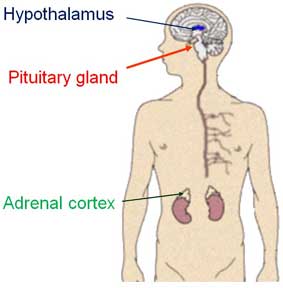On This Page:
Stress is a biological and psychological response experienced upon encountering a threat that we feel we do not have the resources to deal with.
A stressor is a stimulus (or threat) that causes stress, e.g., an exam, divorce, the death of a loved one, moving house, or loss of job.
Sudden and severe stress generally produces:
- Increase in heart rate
- Increase in breathing (lungs dilate)
- Decrease in digestive activity (don’t feel hungry)
- Liver releases glucose for energy
Firstly, our body judges a situation and decides whether or not it is stressful. This decision is made based on sensory input and processing (i.e., the things we see and hear in the situation) and also on stored memories (i.e., what happened the last time we were in a similar situation).
If the situation is judged as being stressful, the hypothalamus (at the base of the brain) is activated.
The hypothalamus in the brain is in charge of the stress response. When a stress response is triggered, it sends signals to two other structures: the pituitary gland and the adrenal medulla.
These short-term responses are produced by The Fight or Flight Response via the Sympathomedullary Pathway (SAM). Long-term stress is regulated by the Hypothalamic-Pituitary-Adrenal (HPA) system.
Chronic stress response: hypothalamic-pituitary-adrenal system ( HPA ) system.
The Hypothalamic-Pituitary-Adrenal (HPA) System

- The stressor activates the Hypothalamic Pituitary Axis
- The hypothalamus stimulates the pituitary gland
- The pituitary gland secretes adrenocorticotropic hormone (ACTH)
- ACTH stimulates the adrenal glands to produce the hormone corticosteroid
- Cortisol enables the body to maintain steady supplies of blood sugar
- Adequate and steady blood sugar levels help a person cope with a prolonged stressor and help the body to return to normal
The adrenal cortex releases stress hormones called cortisol. This has a number of functions, including releasing stored glucose from the liver (for energy) and controlling swelling after an injury. The immune system is suppressed while this happens.
Sympathomedullary Pathway (SAM)
The hypothalamus also activates the adrenal medulla. The adrenal medulla is part of the autonomic nervous system (ANS).
The ANS is the part of the peripheral nervous system that acts as a control system, maintaining homeostasis in the body. These activities are generally performed without conscious control.
The adrenal medulla secretes the hormone adrenaline. This hormone gets the body ready for a fight or flight response. The physiological reaction includes an increased heart rate.
Adrenaline leads to the arousal of the sympathetic nervous system and reduced activity in the parasympathetic nervous system.
Adrenaline creates changes in the body, such as decreases (indigestion) and increased sweating, increased pulse, and blood pressure.
Once the ‘threat’ is over, the parasympathetic branch takes control and brings the body back into a balanced state.
No ill effects are experienced from the short-term response to stress, and it further has survival value in an evolutionary context.
Evaluation
Strengths
- Measuring stress hormones gives an objective measure of stress.
- Fight/flight response can be seen in all mammals in response to threats.
Weakness
- There is considerable variation in the level and type of hormones released by different people and in response to different stressors – not a simple physiological process.
- People without adrenal glands need hormonal supplements to survive stress.
- Symington (1955) found that conscious dying patients showed different stress reactions to unconscious ones. Suggests that psychological factors play a role.
References
Currie, A. R., & Symington, T. (1955). The pathology of the pituitary and adrenal glands in systemic disease in man. Proceedings of the Royal Society of Medicine, 48(11), 908.

